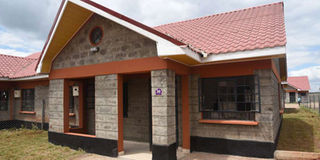With little land, high population, vertical housing is sure way to go

Urithi Housing Cooperative Society's Plainsview Estate in Juja, Kiambu County. PHOTO | FILE | NATION MEDIA GROUP
What you need to know:
- Any disputes relating to sizes and relative positions of boundaries to the units can be resolved as prescribed under the Land Registration Act.
- This is a matter that needs executive attention so that purchasers can obtain good ownership documents as is intended under the Sectional Properties Act.
Africa is gradually appreciating that though comparatively well-endowed with much unutilised or underutilised land, rapid population increase and horizontal developments may be its bane in future.
Consequently, individual nations have been responding to the challenge by adopting vertical developments with commensurate changes to their policies and laws.
But how will purchasers obtain and secure individual titles to their units in such high-rise residential or commercial blocks, yet the units share a common base?
Indeed, high-rise or multilevel developments can be divided into several units that can be separately owned, with the common areas collectively owned.
Different jurisdictions carry different names for this concept where people can own separate units but have collective use and ownership of the common areas. In the United States and Canada, they are referred to as condominiums.
Australia and New Zealand call them strata development and the associated titles are referred to as strata titles. Sectional property development and sectional titles are the terms used in South Africa and here in Kenya.
LAW
So how has Kenya harnessed this concept of vertical development to respond to its housing problem, given its rapidly growing population, which is dependent on our finite stock of land?
Kenya adopted its legal framework for the registration and management of high-rise buildings from Canada’s.
Since 1987, we have had a Sectional Properties Act, now under review to harmonise with the new land laws. This Act provides for the division of buildings into units to be owned by individual proprietors and for the common property to be owned collectively.
Under the Act, a corporation that enjoys perpetual succession manages the common property. Initially, the sectional units were registered under the repealed Registered Land Act.
This is currently done under the Land Registration Act. The resultant titles are backed by accurate surveys and can be easily transferred, charged or mortgaged just like any other title.
Any disputes relating to sizes and relative positions of boundaries to the units can be resolved as prescribed under the Land Registration Act.
LEASE
But Kenya’s uptake of sectional properties has been deplorably slow. It’s perhaps one of our worst lessons.
When some colleagues and I did some study 10 years after commencement of our Sectional Properties law, just about eight thousand units, most of them in Nairobi, had been registered.
But at the time, the main reason for the poor uptake of our sectional property law was circumvention of its use through the Registration of Documents Act. It still is.
The Registration of Documents Act provides for the registration of documents.
Under the Act, simple sketches or architect’s plans are submitted and registered provided that they are numbered to help identify each unit in a block.
Sub-leases are then registered but for a term slightly less than that of the head lease. They terminate just before expiry of the head lease, with all interests reverting to the lessor.
The sub-leases can of course be re-drawn once the lease term is extended. The common areas are managed through some arrangement, usually a registered company.
DISPUTE
This arrangement confers a bundle of rights which is far more inferior to what’s conferred through the Sectional Properties Act.
One, there’s a presumption that the head-lease remains unencumbered all through the life of the sub-leases and that the lessor regularly meets his lease obligations so as not to endanger the sub-lessees.
There’s a presumption too that the management company to the common areas runs well and is never deregistered during the life of the sub-leases.
These presumptions could collapse. And because the plans used to register the individual units are merely sketches not backed by a survey regulated under the Survey Act, disagreements cannot be resolved under our registration law.
So again, a key presumption here is that owners under such arrangements never suffer major boundary disputes.
So then what drives developers and purchasers to take these risks? For many buyers, there’s lack of knowledge ab initio.
DELAYS
Most have just found themselves under such arrangements because they found some flats they liked, and thereafter submitted to the applicable registration process.
They finally are provided with a set of ownership documents and bingo, life moves on. Developers who know the difference have complained of great delays whenever they attempt to register their units under Sectional Properties law.
Sadly, they are right. There are lots of institutional hiccups that frustrate developers with approvals at the county level, then Survey of Kenya and finally the Land Registry.
This is a matter that needs executive attention so that purchasers can obtain good ownership documents as is intended under the Sectional Properties Act.
Then the country can optimise on vertical development.
Mwathane is a surveyor: [email protected]





